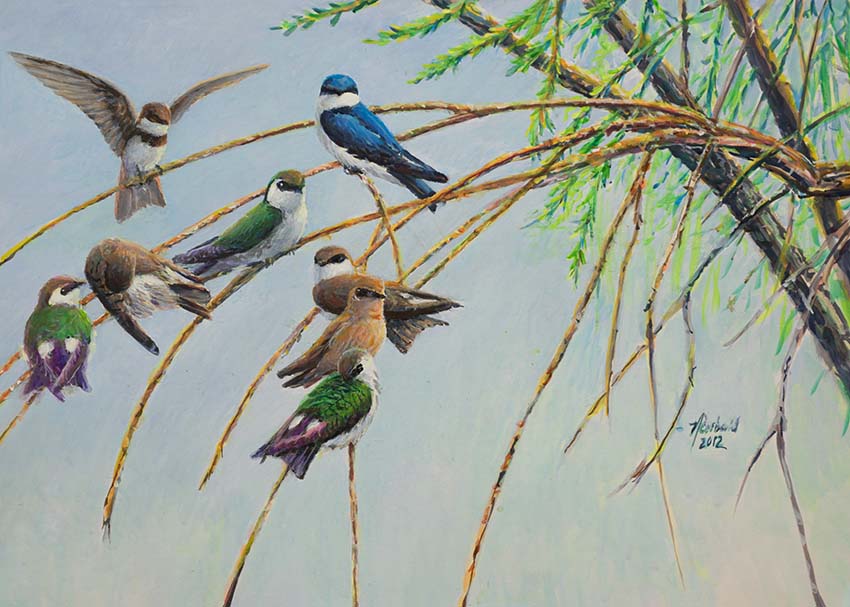
10 Mar Apocolypse Yesterday: The sad but not yet fully hopeless story of Swallows in Seattle (under construction)
By Ed Newbold
posted from Seattle on March 15, 2024
Adapted from a Blog originally published in 2013, when Seattle still had many Swallows
All photos and paintings by Ed Newbold unless otherwise noted
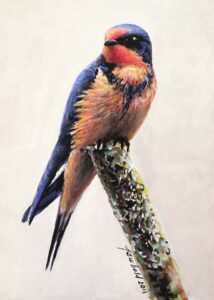
Barn Swallow, painting by Ed Newbold
In 2013 I wrote: Seattle lost its Nighthawks before anyone realized what was happening. Now as we seem to be losing our urban Swallows—it’s a great time to start paying attention!
(Marv Breece on white shot)
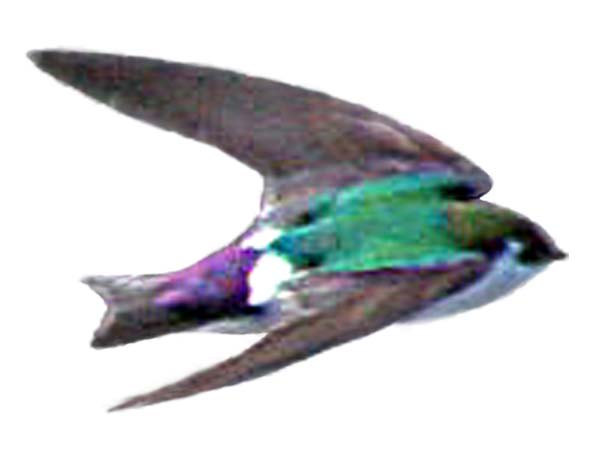
Violet-green Swallow in flight. This photo was taken by Marv Breece, who holds the record for most bird species seen in Washington state in one year. (359)
.
Is there anything we can do to help Swallows &
& other Avian Aerial Insectivores (AAIs)?
Table of Contents:
1 Roster of the Northwest’s Avian Aerial Insectivores.
2. Some things we can do to help swallows and AAIs!
3. What is going on with our AAI populations?
4. What’s driving down populations of AAIs?
5. The amazing Black Swift and what it says about the importance of nest predation
6. (Are some of the prevailing theories wrong &) Have our Nighthawks simply fallen prey to Crow nest predation?
7. Barn Swallows and Humans: Keep the friendship alive
1. Meet the Northwest’s AAIs:
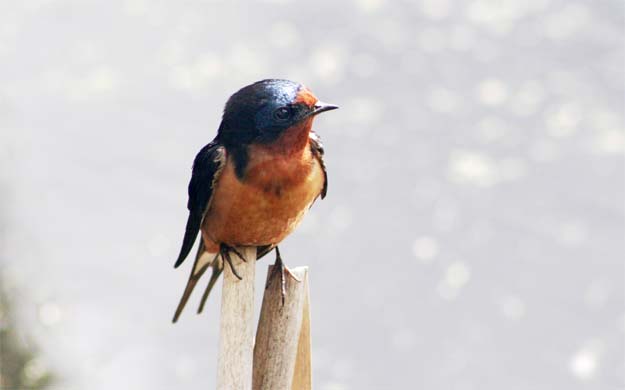
Barn Swallow
This is a male BARN SWALLOW, one of the most wide-ranging and well known of the Avian Aerial Insectivores (AAIs). It’s a classic AAI that does most all it’s foraging on the wing. It’s the only swallow in America with a long “swallow-tail.”
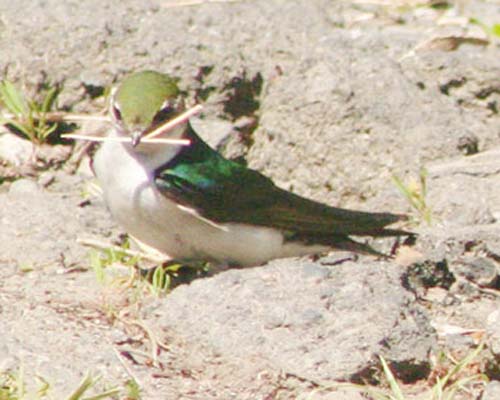
Violet-green Swallow
Here is a VIOLET-GREEN SWALLOW. Good flight shots are hard to get and the flight-shot above the Barn Swallow photo, taken by Marv Breece,* is very revealing. Although I had seen thousands of Violet-green Swallows, until I saw this shot, I never realized the extent of the violet on the trailing parts of the bird. And despite the fact that I knew Violet-green Swallows were great aerialists, the “jet-like” flight profile still took me by surprise. Wildlife photographers teach us about birds as much, in their way, as wildlife biologists do.
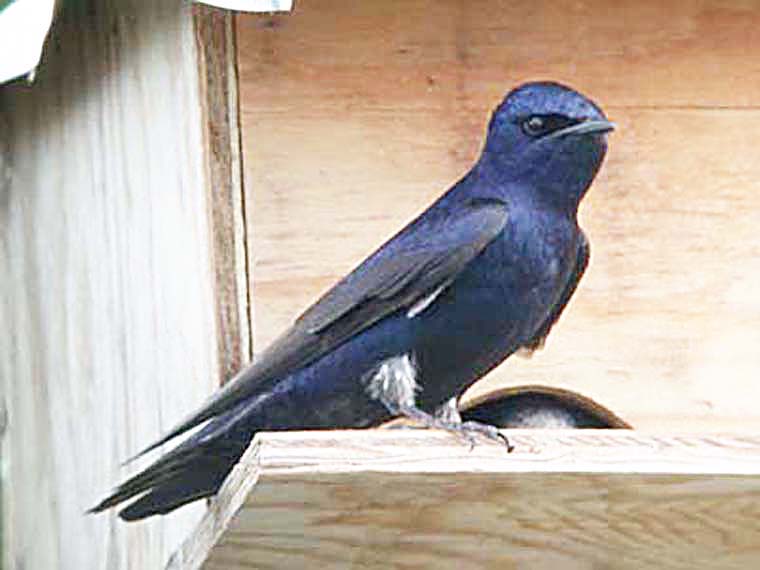
Purple Martin photo by Kevin Li
Purple Martin
PURPLE MARTIN is the largest US Swallow and another Avian Aerial Insectivore. Note the long, pointed wings which are characteristic of many AAIs. This Purple Martin male was photographed by Kevin at Jack Block Park in Seattle. Martins tend to forage higher in the air than other swallows. They eat larger flying insects, especially Darner genus dragonflies. (See Viewpoint 4 for more on Purple Martins).
photos by Ed Newbold
CLIFF SWALLOWS, shown above, nest in colonies, often under large bridges, and build a fully enclosed mud nest. This gives them more protection than Barn Swallows have from nest predation but they must struggle to find good places to build that fit engineering and habitat criteria. Cliff Swallows are the only North American Swallow with a square tail.
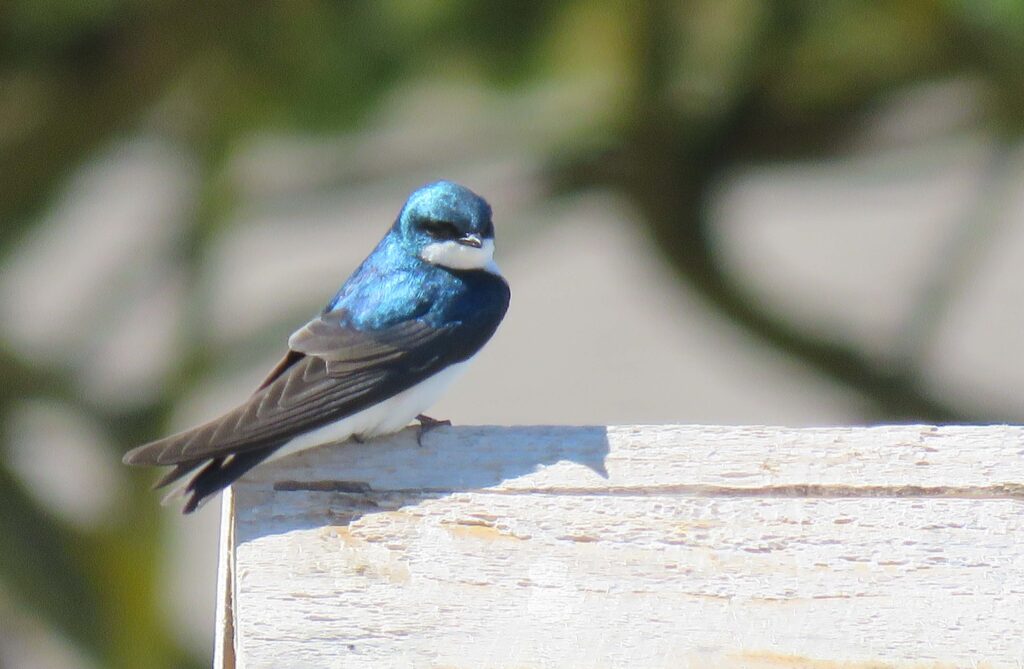
Tree Swallow
TREE SWALLOWS are striking blue and white swallows (these shots by me don’t do them justice) that like freshwater wetlands and lake margins and nest in cavities. They are in the same genus as the Violet-green Swallow, Tachycyneta and also use a cavity or box for nesting.
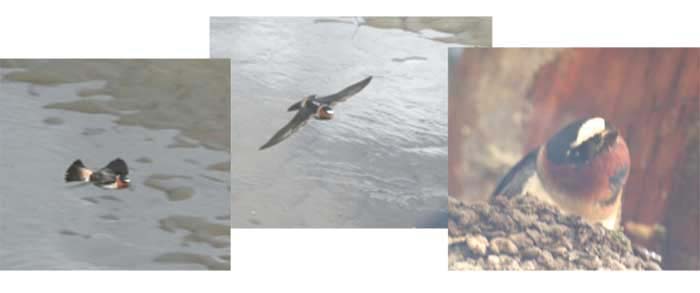
Cliff Swallow
Though Cliff Swallows are closely related to Barn Swallows they have a squared-off-tail. These are colony nesters and are the species that used to return to Capistrano. Cliff Swallows, are embattled in Western Washington and Seattle’s Parks Dept. is one of the reasons. Parks destroyed a colony in Magnuson Park, which I believe is now entirely extirpated (although I’m not sure of that). A large colony on or near the Fremont Bridge has failed in the last 20 years and a colony on the North end of Mercer Island has failed. I the latter cases I don’t know if human landlords had a hand in the destruction.

Rough-winged Swallow and Bank Swallow
Bank Swallows are colony nesters that nest in holes they dig along rivers. Rough-winged Swallows are also hole nesters but are not colonial. A Bank Swallow is alighting in the painting above and a Rough-winged Swallow is looking vigilant in the group of three birds in the center.
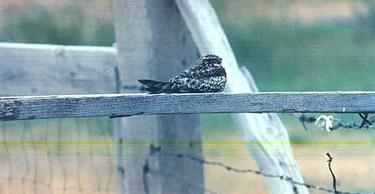
Non-Swallow AAIs: Nighthawk
NIGHTHAWKS are from an entirely different family of AAIs, the Nightjar family Nighthawks are much larger than swallows–wingspread 24″–with very fast acrobatic flight. They are related to the Whip-poor-will and the Poor-will but unlike those relatives, the Nighthawk is not truly nocturnal but rather “crepuscular”–i.e., it prefers to forage in late evening and dusk. They are very tough to photograph in flight–this is a painting of mine. Poor-wills occur in Eastern Washington. They may be in the greatest conservation danger of any of the AAIs in the state.

Non-Swallow AAIs: Vaux’s Swift and Black Swift
Also difficult to photograph in flight are the SWIFTS. Painted for this page, this painting shows, from left to right, VAUX’S SWIFT, BLACK SWIFT, WHITE-THROATED SWIFT & CHIMNEY SWIFT. Of these, only Vaux’s Swifts are summer resident breeders in Western Washington, but especially in spring, Black Swifts are seen throughout the lowland area as they wait for weather systems to move on from their home in the Cascade (or Olympic?) Mountains. (White-throated Swifts nest on cliffs on the eastern side of the state, while Chimney Swift is a bird of the Eastern side of the continent.
(Bats aren’t AAIs, they are MAIs, Mammalian Aerial Insectivores. Bats have their own problems but they are beyond my scope here)

A Violet-green Swallow Dad feeds a kid on the back of our house in the last century. Violet-green Swallows used to fly in a small flock directly to our house, which each year hosted at least one family. Now we don’t see them unless it’s high in the sky on their way North.
Apocolypse Yesterday
Most environmental writing warns of something about to happen, but the AAI crash in Western Washington has already occurred. Many species have already disappeared from most of their traditional breeding sites in Seattle and the Puget Sound lowlands. Barn Swallows and Violet-green Swallows were abundant all through Seattle and in every neighborhood of Seattle–they were truly abundant, as any honest observer who is my age or older will attest, and as recently as the 1980, and diminishingly so in the 90s and oughts. Now it is rare for them to breed in in the city. Nighthhawks were never abundant but were present in summer in every neighborhood of Seattle including the downtown in Summer. Vaux’s Swifts were fun to watch in the evenings as they and the Nighthawks would put on an airshow. These populations are basically gone now, although the decline is not even. Tree Swallows and Rough-winged Swallows may be less affected but started from an immensely lower baseline. All the species do continue to breed in the area in certain favored places. If there is a pure exception to what I’m saying it is the Purple Martin, which may be responding favorably to human action in favor of it’s breeding attempts, begun in the 1990s by Kevin Li and others. Vaux’s Swifts are monitored by an organization which Larry Schwitters is involved with. Vaux’s Swifts have generally disappeared from Seattle, where they used to be common, but their status in the more undeveloped areas of Western Washington is beyond my knowledge area and they continue to roost in Monroe, WA.
Before asking “What went wrong?” Here are ways to help AAIs if you still host them
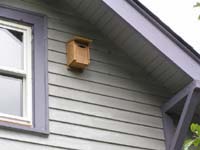
Put up boxes for Violet-green Swallows (or if you’re near water, Tree Swallows)
One gorgeous AAI that really needs help in some places, the Violet-green Swallow, happens to be one of the easiest AAIs to help with nesting.
As “cavity nesters,” Violet-green Swallows have historically sought out old Woodpecker holes to use as houses. Among the critters in the market for such holes, V-gs are low on the military peck-order and must defer to other species such as Starlings and Squirrels. Additionally, woodpeckers and old trees can be very scarce in urban areas, making old woodpecker holes hard to find. This is where the helpful human comes in: Putting up a nest box for them could (! as far as I know, nothing about AAI conservation is known for sure) possibly make the crucial difference between extirpation and survival in some areas.
Violet-green Swallow Nest boxes can be purchased from most Wild Birds Unlimited stores and from Seattle Audubon Society and they can be purchased from the store on this website. They can also be home-made. Use a slot that is either diamond-shaped, oval or rectangular and make the hole about 2 inches wide and absolutely no more than 7/8 ” high. One great design for the hole is a diamond shape with the greatest height 7/8″. The box we sell on this website has a rounded rectangular hole 7/8 ” high.
Maximum dimension here should not exceed 7/8″.
The first time a swallow considers your house, it may look in the box from the outside, appear to try to get in, then fall back away and leave. Do Not Increase the Size of the Hole. They are simply checking for predators, since many cavities they find in nature already have an occupant and sometimes these occupants have a nasty temper.
Place your swallow box under an eave if you live in upland western WA. If you live on a lake or wetland, you can try putting the box on a tree or post and see if you can get Tree Swallows.
It’s great fun to be landlords for Violet-green Swallows. V-gs have a much more placid personality than Barns, not nearly so high-strung, and their “language” is a bit harder to interpret (Their alarm call is like their regular call but piercing and more incessant, their “fighting” vocalization is a low mechanical chatter). Because their kids are protected in a wooden box, they don’t have reason to get excited quite so much about nearby predators the way Barns do. They have a barely audible “dawn song” they sing exactly at sun-up that’s different from their other vocalizations. Their chirping is amazingly cheerful sounding, and they’ll bring their kids back to the box for at least a week after fledging for safe keeping.
Put up nest-ledges for Barn Swallows
Here is a nesting ledge I put up on our front porch stoop at our house. This is a traditional Barn Swallow site.
Here’s another corner of the porch. Although it’s a traditional site, it’s not ideal. Open Carports with high ceilings are ideal, as are large porches. Barn Swallows prefer to fly well in to the far side of the enclosed space. The Barn Swallows are trying to access a spot that is inaccessable to both mammals and to birds that can’t fly well or hover. Crows and Jays, the Barn Swallow’s chief nest-predators, can’t access these sites as they are not aerial-agility specialists.
Install mud basins for Barn Swallows
I used an approx. 3 ft. x 3 ft. piece of Butyl and layed it in the ground where I had dug a slight depression. Then I fill it up with the most clay-like soil I can find, and add water and remix the mud with my hands sometimes daily during high Barn Swallow nest building season (end May early June and all through the summer for failed nesters or double clutching parents). Kids wouldn’t want to do anything like that, but I enjoy it.
Sort of a Barn Swallow Home Depot. Self-checkout.
Here are the two species that will really appreciate a mud basin. American Robins build a very strong mud-and-grass open-cup nest and also will site near human dwellings in the hope of getting protection from Crows. They also are fairly excitable and also use their danger vocalization to get human help. (That’s a muddy strand of grass, not a worm the Robin has).
Help swallows on fledging day
Fledging Day: These three kids have been “told” to wait on the door while a sibling is given flight-training.
Fledging day is a very challenging day for high-strung, nervous Barn Swallow parents. They need to usher each kid on it’s own first flight, drive away predators if the kid lands in the wrong place (which it often does), scold the others into staying where they are supposed to wait for all this, and then repeat the procedure. All this occurs in a space usually of one day, and the dangers during this time are very high. If you have swallows, you might be able (work schedule willing of course) to help by ridding the area of prowling cats and crows.
I use a”high-end” Super Soaker I bought years ago at Fred Meyer. Though it’s sold as a toy, it has held up well for over a decade and lets these critters know they are not welcome in the area on this important day.
Barn Swallows communicate well with humans
When predators appear, Barn Swallows will use call out what sounds to me like “Puh-CHEEK,” clearly in hopes of rousing a human. “Danger!” a loud “Pa-Cheek!” sound repeated as needed. The instant the danger has receded the call will change to “coast is clear” call: a sweet upward “zweep.” During regular good times, Barn Swallows chatter in a very pleasant-sounding not loud voice.
Help save chimneys for Vaux’s Swifts
Vaux’s Swifts nest not only in cavities in trees, but in chimneys. They also retire to chimneys as roosting sites when the breeding season is over and these communal sites protect them from cold and predators.
Vaux’s Swift, ptg by Ed Newbold
The loss of chimneys can be one in the pantheon of threats to AAIs. In Monroe, WA, a chimney at an elementary school serves up to 5000 Vaux’s Swifts–the sight of the birds swirling into the chimney at dusk is one of those great wonders of nature. Many concerned citizens in Monroe have rallied to the cause of keeping this chimney “in business.” Here is a link:
http://www.eastsideaudubon.org/conservation/current-projects-2/save-our-swifts
Reduce Cat predation where it’s a problem
As far as a I know, cat predation on swallows is not a huge problem except at certain time periods and in certain situations. One is nest-building. Violet-green Swallows fly low and spend lots of time on the ground looking for soft nesting material during this period while Barns repeatedly land and gather mud from their mud source. The other time of high risk is fledging, when inexperienced and poor-flying babies land on the ground or other inopportune places after their first flight. If you own a cat that goes outdoors and you see this as a potential problem, the solution is simple, permanent or temporary use of a Catbib.
Here a black cat named Ritchie hunts birds. He won’t get any, because he’s wearing a catbib.
They are only 12 bucks, free shipping, easy to attach to a collar and can be purchased at:
http://www.catgoods.com/
Reduce or zero out use of Pesticides
Regardless of whether farmers should or shouldn’t use pesticides, anyone would agree that they have an excuse to do so: they are producing the huge quantity of food people need to survive. Managers of lawns and yards for the most part are merely seeking an aesthetic so when they need to use pesticides this aesthetic should be vigorously questioned. What plant is so beautiful that it justifies poisoning the environment, especially when other plants that some would say are more beautiful don’t require pesticides?
It’s not known whether or to what extent lawn and yard pesticides are responsible for the decline of AAIs, but why take any risk at all, when all that’s at stake is an aesthetic, and that aesthetic may well be a false one?
Part 2
(I’m posting the rest of the essay up without it’s photos as I’m running out of time-April 8, 2011
Part 3 What’s going on with AAIs?
Worldwide, there appears to be a serious but uneven decline of AAIs going on right now, and scientists aren’t sure why, although there are myriads of suspects. This subject was the topic of an article back in April/May 2009 of National Wildlife magazine by Paul Tolme. Tolme quotes Jon McCracken, the Ontario Program Manager for Bird Studies Canada, as saying that “…aerial insectivores are declining most acutely in Canada and the Northeast. Barn Swallows, Bank Swallows, Common Nighthawks, and Chimney Swifts have decreased more than 70% in Canada in 20 years. Cliff Swallows, Olive-sided Flycatchers, Eastern Wood-pewees, Northern Rough-winged Swallows , Eastern Kingbirds have dropped more than 50%. (Pewees & Flycatchers are “AAI”s that catch flying insects but hunt from a perch rather than flight)
Eastern Kingbird shot.
Here in Seattle–it’s not clear to me what’s happening with the two remaining dominant AAI species, the Barn Swallow and Violet-green Swallow, but it isn’t good. Remembering densities on North Capitol Hill in 1977 that amazed me at the time, I have to suspect we’ve lost both in significant numbers in many areas of town, if not all areas. Barn Swallows, which remain abundant in many places in the state, seem absent in some traditional areas of Seattle while Violet-greens seem to be faring much worse, and appear to be conceding neighborhood after neighborhood. (As one example, there used to be a sizable “colony” near the Train station in south Pioneer Square that was absent in the 2009 season. Violet-greens were present in the past over the Westlake-Denny area and seem to have failed there as another example). Vaux’s Swifts, which apparently used to be fairly common over Seattle (see under Nighthawk section) may have declined significantly in most neighborhoods but seem to be hanging on in small numbers in other areas of the city, for instance along the western shore of Lake WA wherever it is more vegetated.
The case of the Nighthawk, however, is more cut and dried. This big AAI was once a fixture in the downtown and all the neighborhoods on summer evenings, has been completely extirpated from Seattle as a breeding bird since about 1981.
photo by Ed Newbold
Part III What’s driving down populations of AAIs?
Wildlife Biology, it must be noted, isn’t rocket-science. It’s massively more difficult. (If you see a bird killed by a hawk, you mark the column “predation-caused mortality,” but was the victim slowed by malnutrition?). The subject is so inherently difficult, and there is so little interest in it, that it may not progress much further before it’s too late for many species. No one knows precisely what combination of factors–or perhaps what factor—are responsible for many declines. But that doesn’t mean there aren’t plenty of likely hypotheses and some informed opinion out there that can compete for our attention as explanations when there are declines.
I’ll list some leading possible causes that could be responsible, or could share responsibility for the decline of various AAIs, but don’t mistake this essay for science:
photo by Ed Newbold
Flying insect: a species of Darner Dragonfly I believe.
photo by Ed Newbold
and a Skimmer, I believe
1. Decline in flying insect populations–on the wintering grounds, breeding grounds, in the migration corridor or all three or any combination. This in turn could caused by a myriad number of inter-related causal factors, from habitat destruction, to pesticides, to the plumbing and de-watering of the landscape, to loss of wetlands, to invasive species, weather, etc.
This is the causal factor considered most important overall by McCracken, the ornithologist quoted in the NWF article.
2. Weather and/or climate factors.
Cold and inclement weather in the breeding season has traditionally been viewed as the single largest cause of mortality for AAIs. It could probably be said that of all birds, AAIs are the most needful of “good weather” because they not only need insects, they need them to be flying and since they are migratory, they need good weather in their wintering grounds, breeding grounds (especially) and in between.
Neither weather nor climate–including both the notion of “global warming” and “global wierding” as well as the more simple notion of “bad-luck weather”– can be ruled out easily when looking at some of the AAI declines and down-spikes in specific populations. When you don’t know anything, you can’t rule out anything. However, it seems unlikely to me that weather or climate is responsible for the loss of the Nighthawk which occurred in the period approximately 1975-1981.
These two Barn Swallows are foraging at the Seattle Zoo, not a playfield run by the Seattle Parks Dept., which would no doubt have been astro-turfed by now
3. Habitat loss. This is another huge, hard to evaluate issue. Additionally, it is interconnected with all the other factors in ways that are difficult to disentangle. For some populations, like Barn & Violet-green Swallows that nest in upland Seattle neighborhoods, or Chimney Swifts in old east coast suburbs, there seems to have been little apparent change in land-use over the time period in which declines have been seen.
4. Habitat: Stress-time Foraging areas. During cold and inclement weather, AAIs from all over the region tend to concentrate on the very best places to hunt low-lying insects. These can be wetlands, forested areas, wet forests, low-lying wet grasslands, lakes and lake margins, vernal pools, etc. I call these “Stress-time foraging Areas.” If that moist, low-lying grass ball-field has recently had an expensive makeover and is now covered in turf, or if a wetland area has been filled in and developed, these small changes in one spot could render more sub-marginal all the upland residential habitat around it–where land-use has been static–in the surrounding area.
AAIs are all migratory and the situation in Central and South America affects them mightily–while they breed here, they actually “live” there, spending about 8 months there to their four months here. When birds have nesting success but still don’t return the next year, problems on the wintering grounds or migration route could be the problem.
4. Nest Predation. I’ll start with a disclaimer. I’m a wildlife artist, not a wildlife biologist and have not had training in the science, nor have I collected real data on this issue nor have I even reviewed the scientific literature. Having said that, let me simply assert my opinion: nest predation is often vastly underestimated as a cause of extinction in birds just as it in my opinion is understated in importance in the extinction of the other great group of “birds,” the dinosaurs.
Corvids, which include Crows, Ravens, Magpies on the Eastside in WA, and Jays, are major bird-nest-predators and many have experienced population increases in the same general time frame as AAIs have declined. Although this alone proves nothing, it puts a flag up to take a closer look at this factor. Scroll down for my take on the Nighthawk demise and Crow predation in Part 6.
Other possible nest predators include species such as the Eastern Gray Squirrel, Norway Rat and Racoon, all seemingly doing well of late. For a ground-nesting AAI like the Whip-poor-will, which does not live in the Northwest, there are almost countless nest predators including all these critters as well as Striped Skunks, Opossums, house cats, feral cats, and indeed, Whip-poor-wills have shown some of the greatest declines among AAIs. (Their relatives the Poor-wills nest in eastern Washington are currently experiencing population collapeses.)
5. Lack of nest sites. Some of these species nest in natural cavities such as holes made in trees by woodpeckers. A lack of old-growth and dead and dying big trees and also a concurrent decline in woodpecker species could be a factor in some cases. This seems deductively to be a likely cause of Violet-green Swallow declines in urban neighborhoods: Where can they nest? Some have suggested that the decline in Nighthawks is the result of the move away from flat pebble rooves, which used to be in vogue but are not now. Nighthawks prefer these sites to other types of flat rooves apparently both for camouflage and heat management.
6. Nest-site competition. Bird species, particularly the House Sparrow, have been seen to evict Violet-green, Tree and Cliff Swallows from nest boxes, or in the case of Cliff Swallows, from the mud houses built by the Swallows. Eurasian Starlings engage in similar fights with Purple Martins although Kevin Li used to consider the House Sparrow to be a greater competitive threat to the Purple Martin, (surprisingly) than the Starling.
I have personally witnessed a House Sparrow who made it his “job,” for hours on end, to do nothing but bully a pair of Violet-green Swallows, despite the fact (?) that he couldn’t access the box they possessed.
7. Rising in predation of adults. As adults, AAIs are all hunted all the time by predators, mostly avian, particularly accipiters (hawks) and falcons. At two periods during the year swallows are particularly vulnerable to ground-based predators. One period is during nest-building, when the adults become captivated with building or furnishing nests with material found on the ground. The other time is fledging day, when the young birds first or second choice of a place to land can be unfortunate. During these periods predation by cats, which normally don’t have access to flying swallows, probably spikes. Whether either of these is a key factor in swallow declines is seems doubtful to me, as cats have been abundant in the urban zone for years, and hawk and falcon densities, though they are probably up, are doubtfully enough different from historical baselines to make a big difference. However, bird-lovers should not flinch when it comes to keeping an open mind about what’s going on.
8. Other, unknown and unexpected factors. Humans aren’t the only ones to get pandemics. A chemical used in livestock husbandry was responsible for the sudden demise of millions of vultures in India in recent years. This is an important category–it’s a catchall for everything and anything I didn’t mention in 1-7, and it’s worrisome.
9. Destruction of nests and nest sites (and nesting adults) by humans.
Judging from many casual conversations I’ve had, the destruction of Barn Swallow nests and Cliff Swallow nests by humans concerned about cleanliness and ironically, attractiveness, is an appallingly serious problem. One particularly egregious case involved of all things the Seattle Parks Dept and Arena Sports in Magnuson Park.
This behavior is in larger terms can be seen as the backstabbing of one old friend by another. This betrayal is the subject of part 7 on this page.
Black Swift, ptg by Ed Newbold
The Amazing Black Swift and the importance of nest predation
The Black Swift doesn’t nest in trees. It doesn’t nest on the ground where anyone might walk. It doesn’t nest on cliffs the way White-throated Swifts do. It has a requirement that no other bird in the country does for where it will put a nest:
It has to be behind a waterfall.
Black Swifts are the largest swifts in the US. One hint in Western WA that you’re looking at a Black Swift rather than the more common (but not very common) Vaux’s Swift is the bird may just decide to glide for a quarter-mile. Black Swifts are fast!
In the Northwest, Black Swifts nest only behind waterfalls. According to an American Bird Conservancy website, “They nest almost exclusively at waterfalls where they place their nest on a moss-covered ledge or crevice in the rock behind the veil of falling water, which they must fly through to get to their nest.”
This web page goes on to state: “Predation is rare because of the inaccessibility of the nest site, thus each pair only lays one egg and they only attempt one nest per year. Unlike most small landbirds, there is no urgency in incubation and rearing of the young because of the security provided by their nest site, so Black Swifts have incubation and nestling periods twice as long as most birds of similar size; 24-28 days for incubation and 40-45 days for the nestling period.”
Let’s consider now, the meaning of all of this. To my mind, it speaks hugely to the importance of nest-predation in the survival and evolution of AAIs (not to mention all bird species.) To think that this problem is so serious that a bird would go to the trouble of commuting to and limiting themselves to places as rare and inaccessable as waterfalls, essentially conceding for breeding purposes all other places on earth, drives home the fact that nest predation is serious business .
In my discussions of the local extirpation of the Nighthawk, I encounter what I see as an illogical reluctance to attach too much importance to nest predation as a causal factor. I attribute this to kindness on the human’s part: they don’t want to seem to be blaming a critter, in this case the Crow, for what they see, rightly, as a human-caused problem. I often feel the need to point out that no, I don’t “blame” the Crow, and no, I don’t “hate” Crows, even though I do suspect they were the agents of extirpation here.
It’s with this in mind that I’d like to ask readers to reassess what they think is going on with the Common Nighthawk, a bird that is almost evaporating before our eyes from the continent.
A lay-persons wildlife biology hypothesis:
Have our Nighthawks simply fallen prey to Crow-nest-predation?
Nighthawks used to be common in Seattle
Nighthawks used to be common over Seattle. In 1999, Amy McQuade of Mercer Island wrote the following words to tweeters, a bird-sightings chatline based in Seattle: “Nighthawks used to be plentiful in Seattle. I grew up during the 20’s on Beacon Hill ‘s 12th Avenue South. Summer-evening skies were alive with them,
and what my mother called “Chimney swifts” (no doubt Vaux’s).”
Ed Swan, noted birder from Vashon Island, wrote this to tweeters the same year: “I grew up on the west side of Olympia on Ken Lake , just off the freeway exit to Black Lake . Through the late 1970’s, they were common in the summer. In the 1980’s I went to college and when I eventually returned to the west side of the Cascades realized they were no longer to be expected.”
Let’s throw one more in, this from birder and conservationist Diann MacRae: “I’m not sure if this will add much to the discussion, but I remember nighthawks in very large numbers, so thought I would throw something in . . . When my son was born in 1968, I spent many evenings in the late summer and early fall listening to and watching the numerous nighthawks. This was in Lynnwood, at the time. Trips to Seattle for various evening events such as a parade were always accompanied by the bzzzt/beep of nighthawks overhead. We moved to California and then on to New Hampshire in 1969, returning to the Seattle area in 1981 – and to no nighthawks!!! We were in the original house for a short time, but even during the migration time when they had been very numerous they were almost non-existant. Here in Bothell, where I have lived for 15 years, I have never heard or seen a nighthawk. We do have three bats over our road, though, so there must be some evening insects. “
No, let’s add one more, this time from conservationist/birder Irene Wammer: ” When I was a kid in the 50s, they were always plentiful over the U District in the summer.”
So what happened?
It is likely that prior to the settling of the Northwest by pioneers Nighthawks nested on logjams on rivers, (citation: need) which at that time covered massive amounts of territory. Destroying the logjams and diking the rivers was job # 1 for the settlers, so the Nighthawks made a change in their nesting strategy. Nighthawks, which can’t nest in forests, then apparently moved en masse to rooftops, as they did throughout the country. On a flat rooftop, Nighthawks were safe from most earthbound mammalian predators, and in most places humans left them alone: the strategy was extremely successful probably from the mid or late 1800s through the 1950s.
My experience
My own personal experience with Nighthawks in Seattle I now realize came right during the steep final downward curve of this roof-top-based population. I arrived in the fall of 1976. In the next couple of summers I noted with delight that “every neighborhood seems to have a pair of Nighthawks!” I heard their call as I watched the Torchlight Parade. And although I wasn’t paying close attention, in the early 80’s sometime I began to realize that there weren’t any Nighthawks–this wasn’t a reduction, they were completely gone.
As I searched for causal factors I discussed birds with an old-timer whose name I sadly failed to record. He told me: “There were no Crows in Seattle in the 40s. There might have been a few coming into the city in the 50s. They didn’t start to become common until the 70s.” This reminded me of my experience in Pennsylvania. In 1963 I remember seeing a Crow on our property. It took off as soon as it saw me, obeying a perhaps 400 ft. flight distance.
Let me now assure the reader that I don’t believe that simply because I’ve tentatively established a chronological association between the rise of the urban Crows and the demise of the urban Nighthawks in Seattle, that I have “proven” anything.
But there are powerful commonsense deduction-based reasons to favor the Crow-nest-predation hypothesis as the reason for the urban extirpation of Nighthawks in the Northwest.
Chief among these is the thoroughness of the extirpation: if it were simply changes in roof-styles or declining insect loads, wouldn’t there have been a concommitant decline in Nighthawks rather than a zero-ing-out of Nighthawks?
The continued survival, at very low levels, of Nighthawks nesting in clearcuts throughout the Puget Sound basin is consistent with the Crow hypothesis: these are areas of very low Corvid population density.
The core argument for Crow predation relies not at all on evidence from a decades-old crime scene but from observational common sense: Isn’t it preposterous to think that a Nighthawk family could raise young for 7 weeks on any roof-top in Seattle (or any other NW city) and not have the kids fall victim to Crows? The very notion that they could is almost preposterous to me. Moreover, it feels borderline disrespectful of Crows, who can easily overpower a Nighthawk, who never miss a chance to nest-predate when they have their own kids to feed, and who make it a point to know exactly what’s going on in their neighborhood by watching over it carefully every single day.
The Pebble Roof Theory
It should be noted that there is a competing hypothesis currently in favor among those concerned about the Nighthawk. Let me quote a page on Nighthawks form Audubon Birdscapes a resource of the National Audubon Society on Nighthawks at
http://blog.audubon.org/cs/blogs/birdscapes/archive/2008/12/09/birds-to-help-common-nighthawk.aspx.
In 1986, Vincent Marzilli studied the nighthawks nesting on rooftops at the University of Maine. Noting that many of the gravel rooftop nesting sites were being replaced by rubber roofing, he installed gravel pads on these rooftops as artificial nesting sites. Marzilli put up 14 gravel patches on 7 buildings, and was able to attract nesting nighthawks to 3 of the patches located near the southern corners of buildings.
In several areas, bird conservationists are trying to repeat Marzilli’s experiment and attract nesting nighthawks to gravel nesting pads on rooftops. In Northwestern Pennsylvania, Tim Hoppe with the PA Game Commission has put up 21 nest pads on buildings in Erie, Meadville, Oil City, and Warren. So far, no nighthawks have used any of the pads–which are made by putting 400 lbs of pea gravel on landscaping fabric in the corners of rooftops
In my opinion the pebble roof problem may well exist for Nighthawks, but as an explanation for their demise in the Puget Sound urban zone, it seems flawed. If rooftop nesting was a viable strategy for Nighthawks wouldn’t there be some flat areas in a city the size of Seattle that worked, even if every pebble roof was converted to vinyl by 1981?
If this page is right and Crows are more or less the sole cause of the Nighthawk’s downfall, then we are indeed in a grim situation. A 2004 report from the National Audubon Society called “State of the Birds” reports that the Nighthawk, “though able to breed on city rooftops throughout North America, this species’ population has dropped by half, to about 11 million birds.” Anyone reading this would feel reassured: 11 million birds!
But of those “11 million birds” (no doubt an optimistic number), the ones currently nesting on rooftops should in my opinion be viewed as essentially absent from the future populations, given the relentless expansion of Crows into cities and towns and the speed with which these populations have collapsed in the past. And in my view that speed won’t be affected by humans trying to help if they are focusing on the wrong problem, i.e. roof substrates rather than nest predation.
This would leave the few Nighthawks nesting in clearcuts, mountaintop rock outcrops and other desolate places as concievably the last remaining hope for a species that, although it is captivating to most humans who see it, can’t seem to ever get the attention of the environmental movement or the body politic.
“Fly free or Die:” Zoos won’t be there to save the Nighthawk
If you recieve emails or calendars from Defenders of Wildlife, World Wildlife Society, or many other environmental organizations you’ll see many references and pictures of Polar Bears and Gray Wolves. Not to take anything away from these critters or their problems, but the Nighthawk as a species is playing a much more serious game of poker. Most mammals (with the exception of the MAIs and big whales) can be thrown in a cage with a mate and they’ll reproduce ad infinitum, if I may so rudely reduce the art & science of zoo husbandry. Not so with Nighthawks. This is a bird that is linked to the ecosystem and needs “elbow room”–a big and fast bird that covers many miles in a single foraging session. This makes it unlikely that captive breeding is an option, and if we lose the birds flying free above us, we will have lost them forever.
Links to people trying to help the Nighthawk: Project Nighthawk (New Hampshire)
http://nhbirdrecords.org/bird-conservation/Nighthawk-main.htm#AboutProject
America–this is our heritage! We must not lose this bird. If we can understand how beautiful it is–so much more than these paintings can ever tell–we’ll realize we have no choice but to try and save it!
Barn Swallows and Humans: Are humans betraying an age-betraying an age-old friend?
Currently being written April 2, 2010
The bond between swallows and humans goes back for millenia. Throughout the human world, where people have farmed, there has often developed a relationship with a species of swallow, typically Barn Swallows. The relationship has been a classic example of symbiotic commensalism: both are helped by their assoication with each other. For human farmers, big strong birds such as Corvids are generally an enemy, as they are for the swallows, whom they nest-gredate. The swallows become an “early warning system” for the presence of these birds and especially in the case of Purple Martins which are larger, even a first line of defense. The swallows benefit by using the structure provided by the farmer (thus the name “Barn Swallow”) as well as artillery backup in their eternal war with the crows. (Additionally, the farmer benefited from the hunting of insects by the swallows.)
Purple Martins became colony nesters when American Indians, particularly in the east and midwest of the US, put out gourds for them to nest in over their maize fields and help protect them.
old friend?
Currently being written April 6, 2011
The bond between swallows and humans goes back centuries and exists across continents as the Barn Swallow is among the most cosmopolitan and successful (until recently) of bird species.
Barn Swallows have a symbiotic relationship with farmers. Barn Swallows and farmers have always shared a dislike for large Corvids and other large nest-predacious birds (Crows, Magpies, Ravens, Jackdaws, Carrawongs, etc.). Swallows hate them because they eat their babies, farmers because they eat their crops. Barn Swallows and in some cases other swallows such as Purple Martins provided early warning for the appearance of corvids and provided the first line of aerial defense. Then the farmer heard the loud danger call of the swallow and came out with whatever weaponry the farmer had. The farmer also allowed the Barn Swallow to put a nest on his house or barn where it was safe from rain and predators and close to the doorway. Many have noted the Barn Swallow’s preference for being near a doorway. (They need the farmer to emerge quickly when they call.) Indians in North America were said to have induced Purple Martins to live in colonies above their maize fields by putting out gourds with holes in them. The symbiotic relationship was so successful that Barn Swallows more or less completely abandoned what we would call “natural” nest sites in favor of houses and barns near doorways. There is no such thing as a “wild” Barn Swallow.
It all worked. In China, Barn Swallows were said to bring good luck. In Europe, Swallows nests are still welcome on thousand-year old buildings. But here in America, wealth and a sense of superiority over the Creation created a hubris in some humans that led them to believe they were too good to be a host for their old friend, and began to coldly and systematically destroy the nests these birds built and the families they were trying to raise and feed and educate. (Swallows stay with their parents for weeks learning to forage and then learning the rigors of the long migration that go as far as southern Argentina in the case of Barns).
It became so bad that a colony of Cliff Swallows was destroyed in a Seattle Park (Magnuson) with the full approval of the Park Dept. and a dismissive, disrespectful quote from the head of the youth athletic company that wanted the birds gone.
. There can’t be anyone still reading this blog, it’s gone on too long. But it’s possible someone could have scrolled to the end, and they deserve a happy ending. I’ll post a great shot of 5 baby swallows as soon as I get permission

Sorry, the comment form is closed at this time.